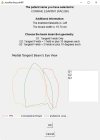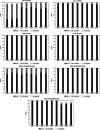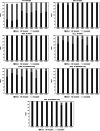Automated treatment planning for whole breast irradiation with individualized tangential IMRT fields
- PMID: 38642406
- PMCID: PMC11087165
- DOI: 10.1002/acm2.14361
Automated treatment planning for whole breast irradiation with individualized tangential IMRT fields
Abstract
Purposes: This study aimed to develop and validate algorithms for automating intensity modulated radiation therapy (IMRT) planning in breast cancer patients, with a focus on patient anatomical characteristics.
Material and methods: We retrospectively selected 400 breast cancer patients without lymph node involvement for automated treatment planning. Automation was achieved using the Eclipse Scripting Application Programming Interface (ESAPI) integrated into the Eclipse Treatment Planning System. We employed three beam insertion geometries and three optimization strategies, resulting in 3600 plans, each delivering a 40.05 Gy dose in 15 fractions. Gantry angles in the tangent fields were selected based on a criterion involving the minimum intersection area between the Planning Target Volume (PTV) and the ipsilateral lung in the Beam's Eye View projection. ESAPI was also used to gather patient anatomical data, serving as input for Random Forest models to select the optimal plan. The Random Forest classification considered both beam insertion geometry and optimization strategy. Dosimetric data were evaluated in accordance with the Radiation Therapy Oncology Group (RTOG) 1005 protocol.
Results: Overall, all approaches generated high-quality plans, with approximately 94% meeting the acceptable dose criteria for organs at risk and/or target coverage as defined by RTOG guidelines. Average automated plan generation time ranged from 6 min and 37 s to 9 min and 22 s, with the mean time increasing with additional fields. The Random Forest approach did not successfully enable automatic planning strategy selection. Instead, our automated planning system allows users to choose from the tested geometry and strategy options.
Conclusions: Although our attempt to correlate patient anatomical features with planning strategy using machine learning tools was unsuccessful, the resulting dosimetric outcomes proved satisfactory. Our algorithm consistently produced high-quality plans, offering significant time and efficiency advantages.
Keywords: artificial intelligence; automated planning; breast cancer; radiation therapy.
© 2024 The Authors. Journal of Applied Clinical Medical Physics is published by Wiley Periodicals, Inc. on behalf of The American Association of Physicists in Medicine.
Conflict of interest statement
The authors declare no conflicts of interest.
Figures




Similar articles
-
Automated Field-In-Field (FIF) Plan Framework Combining Scripting Application Programming Interface and User-Executed Program for Breast Forward IMRT.Technol Cancer Res Treat. 2018 Jan 1;17:1533033818810391. doi: 10.1177/1533033818810391. Technol Cancer Res Treat. 2018. PMID: 30384804 Free PMC article.
-
Automated planning of tangential breast intensity-modulated radiotherapy using heuristic optimization.Int J Radiat Oncol Biol Phys. 2011 Oct 1;81(2):575-83. doi: 10.1016/j.ijrobp.2010.11.016. Epub 2011 Jan 13. Int J Radiat Oncol Biol Phys. 2011. PMID: 21237584
-
Automated Hypofractionated IMRT treatment planning for early-stage breast Cancer.Radiat Oncol. 2020 Mar 17;15(1):67. doi: 10.1186/s13014-020-1468-9. Radiat Oncol. 2020. PMID: 32178694 Free PMC article.
-
Advances in Automated Treatment Planning.Semin Radiat Oncol. 2022 Oct;32(4):343-350. doi: 10.1016/j.semradonc.2022.06.004. Semin Radiat Oncol. 2022. PMID: 36202437 Free PMC article. Review.
-
Is full-automation in radiotherapy treatment planning ready for take off?Radiother Oncol. 2024 Dec;201:110546. doi: 10.1016/j.radonc.2024.110546. Epub 2024 Sep 24. Radiother Oncol. 2024. PMID: 39326522 Review.
Cited by
-
An automated treatment planning portfolio for whole breast radiotherapy.Med Phys. 2025 Mar;52(3):1779-1788. doi: 10.1002/mp.17588. Epub 2024 Dec 19. Med Phys. 2025. PMID: 39699058 Free PMC article.
-
BreastWatch: A Varian Eclipse script tool for Community-Based automatic evaluation of breast treatment plans.J Appl Clin Med Phys. 2025 Jun;26(6):e70080. doi: 10.1002/acm2.70080. Epub 2025 Apr 1. J Appl Clin Med Phys. 2025. PMID: 40170438 Free PMC article.
-
Fluence smoothing evaluation for whole-breast automatically generated treatment plans.J Appl Clin Med Phys. 2025 Feb;26(2):e14564. doi: 10.1002/acm2.14564. Epub 2024 Nov 29. J Appl Clin Med Phys. 2025. PMID: 39611818 Free PMC article.
References
-
- Bakx N, Bluemink H, Hagelaar E, et al. Reduction of heart and lung normal tissue complication probability using automatic beam angle optimization and more generic optimization objectives for breast radiotherapy. Phys Imaging Radiat Oncol. 2021;18:48‐50. doi:10.1016/j.phro.2021.04.002 - DOI - PMC - PubMed
-
- Cilla S, Romano C, Macchia G, et al. Automated hybrid volumetric modulated arc therapy (HVMAT) for whole‐breast irradiation with simultaneous integrated boost to lumpectomy area: a treatment planning study. Strahlentherapie und Onkologie. 2022;198(3):254‐267. doi:10.1007/s00066-021-01873-3 - DOI - PubMed
MeSH terms
LinkOut - more resources
Full Text Sources
Medical

